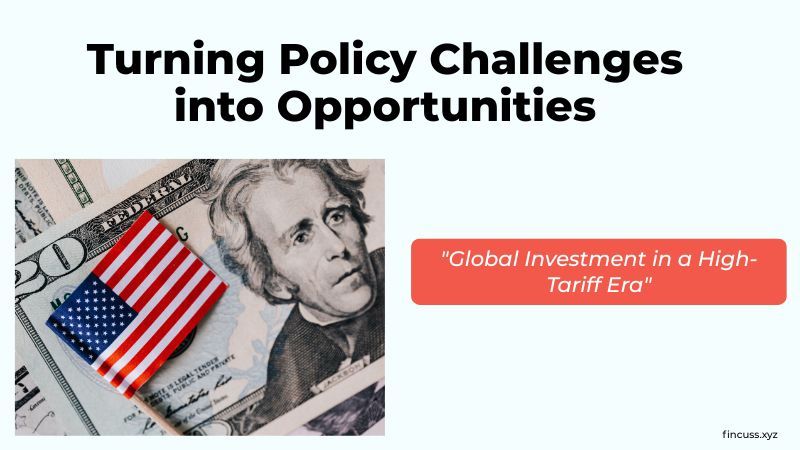Navigating the Tariff Storm: How U.S. Trade Policy is Shaking Up Global Investment
-
The investment landscape is changing significantly due to "mega forces" affecting strategies. U.S. trade policy is rapidly evolving, with increasing tariffs and protective regulations creating both opportunities and risks for global investors. Understanding these changes and adopting a strategic approach are vital for success in this new environment.

The New Reality of U.S. Tariffs
The recent tariff moves from President Donald Trump are shaking up how businesses view international investments. These tariffs are essentially extra taxes on imported goods that companies must pay when bringing products into the U.S. The goal here is to boost American manufacturing, generate more tax revenue, encourage people to buy locally, and reduce the U.S. trade deficit.
Quantifying the Tariff Shock
The U.S. has really stepped up its trade protectionism, and tariffs are hitting historic highs.
1. High Rates: The average tariff rate in the U.S.
2. Types of Tariffs: Here are the three main types to keep in mind:
- Sectoral Tariffs: These hit specific industries hard, such as a 25% tax on autos and parts, and a whopping 50% on steel and aluminum.
- Universal Tariffs: There is also a general 10% tariff on most imports, aimed at bringing in more revenue and supporting local production.
- Country-Specific Tariffs: Some countries face higher tariffs due to negotiations. For example, China has been slapped with tariffs over 145%, while Switzerland has one of the highest at 39%.
3. Expanded Coverage: The new rules have ended the $800 de minimis exemption for non-postal commercial shipments, meaning cheaper goods are no longer flowing through duty-free.
Economic Fallout: Growth, Inflation, and Uncertainty
The fallout from these tariffs is quite widespread, causing significant fluctuations in global growth.
1. The Inflationary Squeeze: There is a strong link between tariffs and inflation. Tariffs act like a tax on imports, which means that much of the extra cost falls squarely on sellers and consumers at home.
-
Increased Costs: When the price of imported goods goes up, businesses might see their profits shrink, and customers end up paying more. This can make people reluctant to spend.
-
Price Projections: Experts believe these tariffs could increase personal spending prices by about 1–1.5% this year. We’re already seeing prices rise on everyday items like coffee and tomatoes.
2. Market Volatility and Recession Risks: The uncertainty surrounding these trade policies has sparked a sell-off in riskier assets, with the S&P 500 dropping 10% within just two days of the tariffs being announced.
-
Persistent Uncertainty: This volatility is unlikely to fade away anytime soon, especially as negotiations and potential backlash unfold. This unpredictability can significantly hinder companies from making long-term investments.
-
Recession Risks: If these tariffs remain at these high rates, we might be headed for slower growth and high inflation in the U.S., which could even lead to a global recession. J.P. Morgan Global Research has estimated a 40% chance of a global recession this year due to changes in U.S. trade policy.
Investment Strategies: Where Capital Is Moving
With everything shifting, investors need to be proactive and pay attention to sectors and companies that could either benefit from or withstand the pressures of tariffs.
1. The Reshoring Trend: Companies around the globe are changing their game plans because of these tariffs, with many bringing production back to the U.S.
- Investment Signals: Between November 2024 and July 2025, many investors noted that tariffs were a significant reason to focus on U.S. production, with 36 companies even considering starting new operations here.
- Incentives: Local governments are stepping up, offering tax breaks and other incentives to bring manufacturing back home, which cover major costs for things like land and equipment.
2. Investment Focus Points:
- Technology and Life Sciences: A significant portion (21.8%) of companies is looking to expand in the U.S.
- Manufacturing and Construction: To avoid tariffs, manufacturers are aiming to expand their operations in the U.S.
- Defensive Positioning: Sectors like healthcare and utilities tend to be more stable since people always need their services.
- Portfolio Diversification: In these unpredictable times, many investors are looking to gold as a way to diversify.
Conclusion: Strategy in Uncertainty
Right now, the trade landscape is all over the place, making it tough to predict what’s next. Even with the uncertainty, there are still opportunities for those willing to adjust their strategies. These new tariffs definitely mark a significant shift in U.S. trade policy with far-reaching effects. As long as you stay updated on the changes, look into ways to handle tariffs (such as reshoring incentives), and focus on sectors that can thrive, you’ll be in a good position.
-
With global markets constantly shifting, emerging economies growing faster, and the U.S. dollar facing periodic fluctuations, should I start paying more attention to international investments? Is it risky to stay too focused on domestic assets? Would diversifying abroad provide better long-term stability and growth, or does it expose investors to unnecessary geopolitical and currency risks?
-
Yes, paying attention to international investments makes sense today. Diversifying globally can reduce dependence on one economy and capture growth from emerging markets. However, it’s important to balance this with an awareness of currency fluctuations, geopolitical risks, and your overall risk tolerance before investing abroad.
